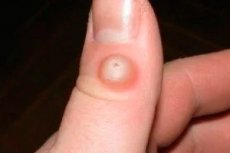Medical expert of the article
New publications
Bubbles after cauterizing warts
Last reviewed: 04.07.2025

All iLive content is medically reviewed or fact checked to ensure as much factual accuracy as possible.
We have strict sourcing guidelines and only link to reputable media sites, academic research institutions and, whenever possible, medically peer reviewed studies. Note that the numbers in parentheses ([1], [2], etc.) are clickable links to these studies.
If you feel that any of our content is inaccurate, out-of-date, or otherwise questionable, please select it and press Ctrl + Enter.

Warts are not life-threatening, but they can be unpleasant and sometimes painful, especially if they are located on the soles of the feet. Women are concerned about growths on the face, because they spoil the appearance. People with warts on their hands feel uncomfortable, because they are viral in nature, which means they are transmitted through handshakes, touching the same objects. Sooner or later, the decision to remove them is ripe. One of the effective and low-trauma methods is cauterization with liquid nitrogen, although it can leave a blister after removing the wart.
Liquid nitrogen is used to freeze and destroy tissue. This quality allows warts to be "burned out" with cold in a few sessions. This procedure is called "cryodestruction". It is performed in a beauty salon. [ 1 ]
How does it happen? No special preparation is required, the main thing is that there is no rash or damage to the skin around the formation. The area is wiped with alcohol, liquid nitrogen (nitrogen) is applied to the affected area. Under its action, the wart becomes pale and dense, and after a minute it turns red and swells. [ 2 ]
After cryodestruction of the wart, a blister appears after a few hours, which may only dissolve after a week, leaving behind a crust, and after it disappears, a pinkish spot. [ 3 ]
It is strictly forbidden to puncture the blister yourself, but if it happens that it bursts on its own, then several times a day you need to treat it with a solution of potassium permanganate, brilliant green or other disinfectants. To avoid infection getting into the wound, it is recommended to cover it with bactericidal glue. [ 4 ]
Apart from such a minor consequence as a blister from a nitrogen burn and the impossibility of doing it at home, the procedure has a number of positive aspects: it does not take much time, is not very painful, does not cause bleeding, does not require special care after it is performed, does not leave scars, and has few contraindications (hypertension, pregnancy, viral and colds accompanied by high temperature).

